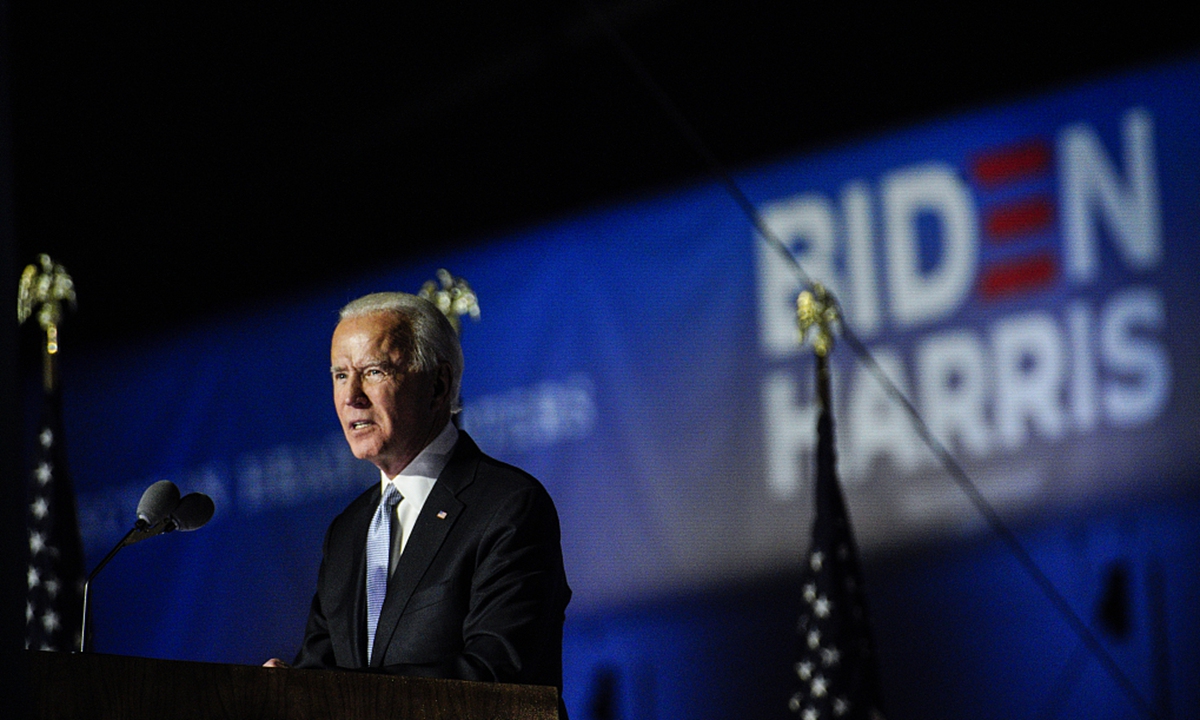How will Biden play out US Indo-Pacific Strategy?

US president-elect Joe Biden. Photo: VCG
As Joe Biden has declared US president-elect, the fate of many policies under the Trump presidency remains undecided, one of which is the much-touted Indo-Pacific Strategy. Discussions of what policies the Biden administration will adopt in the region and its implications for China have surfaced.
The Trump administration rolled out the new "free and open Indo-Pacific" concept in late 2017. This was seen as a distinct departure from the one advocated by his predecessor Barack Obama - rebalance to Asia-Pacific strategy. Rather than wooing partners and allies as the Obama administration did, the Trump administration cast its focus on economy and trade and used tariffs as the main tactic to pressure China. This was coupled with its strengthening of military presence in the region and resorting to political tools such as human rights to squeeze China's room.
Nonetheless, despite differences in wording and tactics, the fundamental objectives of the Indo-Pacific Strategy and rebalance to Asia-Pacific strategy are the same: containing China's rise in the region.
Trump's defeat in the election does not mean an end of the Indo-Pacific Strategy. Biden is anticipated to adopt a similar way of thinking, although the name of the regional strategy may be different.
In the 2020 Democratic Party Platform released in October, there was no single word of "Indo-Pacific". Still, when it comes to the Pacific, it said the US, "will work to strengthen ties with and between our key allies in the region," which has been consistent with the policies of previous US administrations. The omission of the term "Indo-Pacific" does not mean the Democratic Party attaches no importance to the region or that it will scale down the "Indo-Pacific" to the "Asia-Pacific." What the Democratic government, no matter it is under Obama or Biden, means what it talks of the Asia-Pacific is a broad scope that includes most of the Indian Ocean.
Based on the 2020 Democratic Party Platform and what Biden has said about China so far, the Biden administration will continue to see China as the main strategic competitor of the US. As such, it will continue to pay the utmost attention to China as well as to the Indo-Pacific or Asia-Pacific region where China is playing a vital role. As the key objective is to maintain US hegemony in the region, the Biden administration will further contain and strategically compete with China.
There have been debates about whether Biden will launch a "rebalance to Asia-Pacific strategy 2.0" or just restart the Obama-era rebalance to Asia-Pacific strategy. Biden may coin a new name for his policy, but he will continue with the strategic mentality embedded in policies adopted by his predecessors.
Economically, the Biden administration may rejoin the Trans-Pacific Partnership or some other forms of regional economic and trade mechanisms which exclude China.
In face of US economic encirclement, China can show the region its stance and policy ideas on globalization and free trade, and enhance efforts to promote integration with regional countries including US allies and partners. It can also accelerate promoting regional mechanisms such as the Regional Comprehensive Economic Partnership with ASEAN. This may lead to several closed multilateral mechanisms comprised of different grouping of countries, but China and the US will play key roles in these mechanisms.
Politically, the Biden administration may rely on its alliance system and partners as it outlined in its 2020 Democratic Party Platform to compete with China. Four years ago, when Democratic candidate Hillary Clinton lost in the election, many Chinese strategists felt relieved, as they believed ideological clashes between China and the US would not be a focus under a Republican-led administration. Now the Biden-led US administration may re-emphasize ideologies and values and the differences in political systems between China and the US to woo so-called like-minded countries.
Nonetheless, most countries in the region will not be trapped in Washington's rhetoric of getting them to choose the US over China. And although these countries may not say no to US maneuvers such as muscle-flexing in the Asia-Pacific region, they do not want to take sides, not to mention a direct military clash with China. China, based on is diplomatic principles, can work on boosting ties with Belt and Road countries to expand its circle of friends to offset the US strategic pressure.
The author is an associate research fellow with the National Institute of International Strategy at the Chinese Academy of Social Sciences. opinion@globaltimes.com.cn